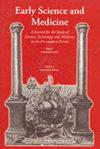弗朗西斯·培根的精神与生命的延续:无生命与有生命的共性与差异
IF 0.5
2区 哲学
Q3 HISTORY & PHILOSOPHY OF SCIENCE
引用次数: 0
摘要
本研究通过对弗朗西斯·培根作品的时间顺序考察,重新审视了他对精神、死亡和生命延长的看法。他的死亡概念通常被认为是独特的,因为它预设了无生命事物的分解和人类死亡的共同物质基础。然而,随着他作品的发展,他对这种共性的关注似乎逐渐消失了——尽管不是完全消失了——从《死者论》到他后来的作品,包括《生命与死亡的历史》。他越来越意识到无生命和有生命之间的区别。《死亡论》坚持认为无生命的灵魂在衰老和死亡中的作用,而《生命与死亡史》则倾向于认为有生命的灵魂是人类死亡的主要原因。我在这篇文章中的建议是,随着培根思想的发展,他们越来越接近传统的衰老和死亡观念。本文章由计算机程序翻译,如有差异,请以英文原文为准。
Spirits and the Prolongation of Life in Francis Bacon: Commonality and Difference between the Inanimate and the Animate
This study reconsiders Francis Bacon’s ideas on spirits, death, and the prolongation of life through a chronological examination of his works. His conception of death has often been considered unique because it presupposed a common material basis for the dissolution of inanimate things and the death of human beings. However, his focus on this commonality seems to have faded gradually – though not completely – as his works progressed, from De viis mortis to his later works, including Historia vitae et mortis. He became increasingly conscious of the difference between the inanimate and the animate. While De viis mortis insisted on the role of inanimate spirits in aging and death, Historia vitae et mortis tended to consider vital spirits as the chief cause of human death. My suggestion in this article is that as Bacon’s ideas developed, they came closer to traditional conceptions of aging and death.
求助全文
通过发布文献求助,成功后即可免费获取论文全文。
去求助
来源期刊

Early Science and Medicine
HISTORY & PHILOSOPHY OF SCIENCE-
CiteScore
0.50
自引率
0.00%
发文量
22
审稿时长
>12 weeks
期刊介绍:
Early Science and Medicine (ESM) is a peer-reviewed international journal dedicated to the history of science, medicine and technology from the earliest times through to the end of the eighteenth century. The need to treat in a single journal all aspects of scientific activity and thought to the eighteenth century is due to two factors: to the continued importance of ancient sources throughout the Middle Ages and the early modern period, and to the comparably low degree of specialization and the high degree of disciplinary interdependence characterizing the period before the professionalization of science.
 求助内容:
求助内容: 应助结果提醒方式:
应助结果提醒方式:


